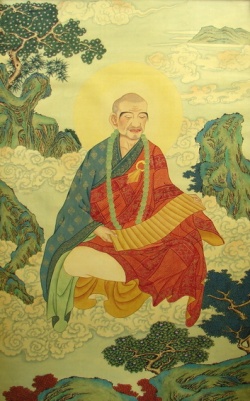Vasubandhu II
Vasubandhu (Skt.; Tib. དབྱིག་གཉེན་, Yiknyen; Wyl. dbyig gnyen) numbers among the ‘Six Ornaments’, the greatest Buddhist authorities of Ancient India. He was the younger brother of Asanga, and composed The Treasury of Abhidharma (Skt. Abhidharmakosha), a complete and systematic account of the Abhidharma, the peak of scholarship in the Fundamental Vehicle. Later he followed the Mahayana Yogachara view, and wrote many works, such as Thirty Stanzas on the Mind (Trimsikavijñapti-karika).
Contents
[hide]
1 His Writings
2 His Disciples
3 Further Reading
4 External Links
His Writings
Abhidharmakosha
Analysis of the Five Skandhas
Thirty Stanzas
Treatise on Karma
Treatise on the Three Natures
Twenty Stanzas
Well Explained Reasoning
His Disciples
He famously had four students who were more learned than himself: Sthiramati, who was more learned in Abhidharma; Dignāga, who was more learned in Pramāṇa; Guṇaprabha, who was more learned in the Vinaya; and Arya Vimuktasena, who was more learned in Prajñāpāramitā.
[世親・天親] (n.d.) (Skt; Jpn Seshin or Tenjin)
A Buddhist scholar in India thought to have lived around the fourth or fifth century. He is known as the author of The Dharma Analysis Treasury. Vasubandhu was born to a Brahman family in Purushapura of Gandhara in northern India. He had an older brother, Asanga. In the central Indian city of Ayodhya, he studied the doctrine of the Sarvastivada school and lectured on The Great Commentary on the Abhidharma, the primary text of that school. He compiled these lectures as The Dharma Analysis Treasury, which presents a comprehensive discussion of the Sarvastivada thought. Thus he became the undisputed master of Hinayana philosophy in India at the time. Vasubandhu at first criticized Mahayana, but later converted to it through the influence of his brother Asanga, whom he assisted thereafter in promoting the Yogachara, or Consciousness-Only, school of Mahayana. Vasubandhu is said to have written a thousand works, five hundred related to Hinayana and five hundred to Mahayana. Among those that have survived are The Twenty-Stanza Treatise on the Consciousness-Only Doctrine, The Treatise on the Ten Stages Sutra, The Treatise on the Lotus Sutra, The Commentary on "The Summary of the Mahayana," and The Treatise on the Buddha Nature. He is counted as the twentieth of Shakyamuni's twenty-three, or the twenty-first of his twenty-four, successors.

